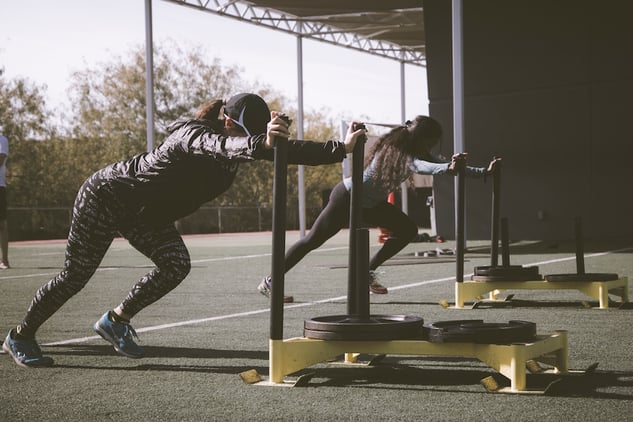When we work out, we’re trying our hardest. We squat low, we power through reps, we meticulously follow instructors, and we aim high. We go until the sweat pours and our muscles tire…. But are we nailing techniques as well as we think we are?
Just because you’re following your trusted sequences and reps, there’s one factor that can make or break your workouts. With this one tip, you can transform your workouts to be more effective, protect you from injury and improve your core.
So enough with the mystery… it’s all about form. Good form, that is.
You might not think form is that important as long as you’re hitting your goals and keeping up with your fitness schedule? But if your form is poor then you risk injury and could damage yourself. But what is ‘good form’ during exercise?

Why is good form so important in fitness?
As mentioned, good form can protect you from injury. This is the most important factor, but the other positives are that it will improve your posture and make sure the targeted muscle group is being worked properly.
If you continue with bad practices, it can misalign your body and put muscles in awkward angles. This can put tendons, muscles and joints under pressure, increasing the risk of muscle strain or tears. These injuries can take months to heal and even produce long-term effects.
Keeping a strong core can work wonders for your form and it will help you fall into the correct positions without thinking twice. Keep on reading to see some great exercises that can improve your core… and how to do them correctly!

Be sure to do your research and find out the correct techniques to use when performing your exercises. Don’t just copy what gym-bod Joe is doing next to you with his dumbbells, and don’t just mimic what you see on social media… unless they’re a fitness expert.
Leading fitness expert and world-renowned life coach, Jillian Michaels, points out that if you copy flawed techniques that you spy on social media or YouTube, you run the risk of damaging your body. Be sure to find demos by fitness experts who can highlight what to do and what not to do during exercises.
A post shared by Lilly Sabri (@lillysabri) on
5 Simple tips to correct your form during exercise
We don’t always have a personal trainer at hand to study our posture, check if our tailbone is tucked in and that we’re engaging our core during workouts. And we sometimes don’t always have access to a mirror during fitness to ensure that our form is correct! Check-out some tips to help you correct your own form during these popular exercises.
1. Cardio
When you’re using a treadmill, elliptical or stair climber, avoid slumping when fatigue hits. Keep your posture tall with a tight core, and have your eyes looking straight ahead to avoid back and neck pain. Also be sure to land softly to avoid jarring your spine and aggravating your joints. Land soft by decreasing your stride length.
2. Sit-ups
Pushing through reps when your abs are screaming can see good form go straight out the window! Pay attention to the muscles you should be using to ensure that they get properly targeted:
- Don’t pull on your neck.
- Don’t arch your back.
- Focus on your stomach muscles curling you upwards.
- Don’t rely on momentum.
- Listen to your body. Feeling tightness and strain? Time to stop.
A post shared by Lilly Sabri (@lillysabri) on
3. Deadlifts and squats
Dropping low or bending with weights can put a lot of pressure on your back. And if you have to sway your body to lift a heavy weight, then you should go lighter. Increase the weight only when you have the technique down pat and have more strength to ensure your form isn’t sacrificed for the heavy weights.
When descending, be sure to engage your core by pulling your belly button towards your spine. Tuck in your tailbone to help this and keep your spine in line. Maintain your natural lumbar curvature - imagine you have a pole running along your spine. Not only will this protect you from injury, but this form will also work them abs!

4. Planks
Traditional planks and side planks can really tighten up your core and shoulder girdle. When performing a traditional plank, do not let your belly or head sag. And keep that butt in line with your spine! Keep the body strong, in a fierce straight line from your ankles through to the top of your head.
Check-out more tips on performing the perfect plank.
5. Kettlebell Swings
Protect your back! It can be extremely easy to put out your back (which we all know SUCKS) so you really have to nail the technique before adding in heavier kettlebells. Pull in the core, tuck the tailbone under, and keep a straight back and neck. It’s not an exercise to strengthen your shoulders so don’t pull up the kettlebell. The focus is on your hips - let the momentum from your hips drive the kettlebell upwards and just control the weight with your arms.
- Ensure your hips are driving the movement.
- Pull your shoulders down and brace your core.
- Do not rely on your back or shoulders to pull yourself up.
- Keep your torso stable by engaging your core and back muscles, and explode upwards using your glutes and hamstrings!
Get more tips on Kettlebell swings here.
Are you using good form during your exercises? Have you noticed twinges and strain during some of your favourite sequences? Follow our tips and stay aware of your body and its movements… and let’s nail this little thing called fitness.


